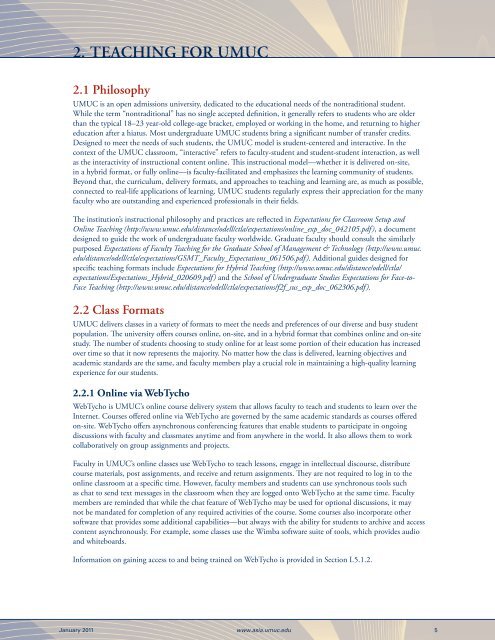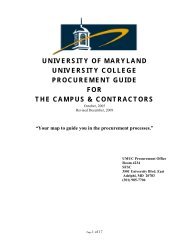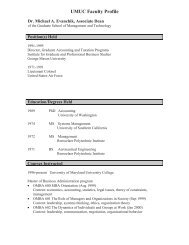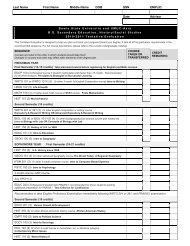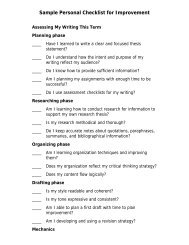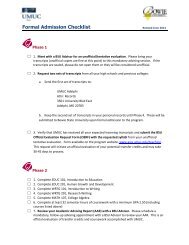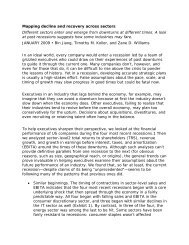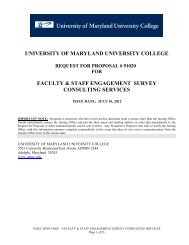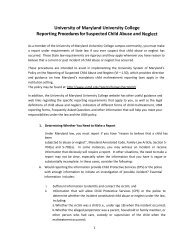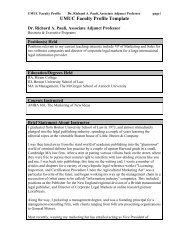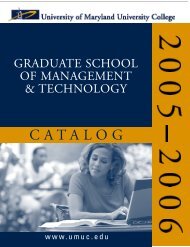Faculty Handbook_Asia_v5 BB.indd - University of Maryland ...
Faculty Handbook_Asia_v5 BB.indd - University of Maryland ...
Faculty Handbook_Asia_v5 BB.indd - University of Maryland ...
Create successful ePaper yourself
Turn your PDF publications into a flip-book with our unique Google optimized e-Paper software.
2. TEACHING FOR UMUC2.1 PhilosophyUMUC is an open admissions university, dedicated to the educational needs <strong>of</strong> the nontraditional student.While the term “nontraditional” has no single accepted definition, it generally refers to students who are olderthan the typical 18–23 year-old college-age bracket, employed or working in the home, and returning to highereducation after a hiatus. Most undergraduate UMUC students bring a significant number <strong>of</strong> transfer credits.Designed to meet the needs <strong>of</strong> such students, the UMUC model is student-centered and interactive. In thecontext <strong>of</strong> the UMUC classroom, “interactive” refers to faculty-student and student-student interaction, as wellas the interactivity <strong>of</strong> instructional content online. This instructional model—whether it is delivered on-site,in a hybrid format, or fully online—is faculty-facilitated and emphasizes the learning community <strong>of</strong> students.Beyond that, the curriculum, delivery formats, and approaches to teaching and learning are, as much as possible,connected to real-life applications <strong>of</strong> learning. UMUC students regularly express their appreciation for the manyfaculty who are outstanding and experienced pr<strong>of</strong>essionals in their fields.The institution’s instructional philosophy and practices are reflected in Expectations for Classroom Setup andOnline Teaching (http://www.umuc.edu/distance/odell/ctla/expectations/online_exp_doc_042105.pdf), a documentdesigned to guide the work <strong>of</strong> undergraduate faculty worldwide. Graduate faculty should consult the similarlypurposed Expectations <strong>of</strong> <strong>Faculty</strong> Teaching for the Graduate School <strong>of</strong> Management & Technology (http://www.umuc.edu/distance/odell/ctla/expectations/GSMT_<strong>Faculty</strong>_Expectations_061506.pdf). Additional guides designed forspecific teaching formats include Expectations for Hybrid Teaching (http://www.umuc.edu/distance/odell/ctla/expectations/Expectations_Hybrid_020609.pdf) and the School <strong>of</strong> Undergraduate Studies Expectations for Face-to-Face Teaching (http://www.umuc.edu/distance/odell/ctla/expectations/f2f_sus_exp_doc_062306.pdf).2.2 Class FormatsUMUC delivers classes in a variety <strong>of</strong> formats to meet the needs and preferences <strong>of</strong> our diverse and busy studentpopulation. The university <strong>of</strong>fers courses online, on-site, and in a hybrid format that combines online and on-sitestudy. The number <strong>of</strong> students choosing to study online for at least some portion <strong>of</strong> their education has increasedover time so that it now represents the majority. No matter how the class is delivered, learning objectives andacademic standards are the same, and faculty members play a crucial role in maintaining a high-quality learningexperience for our students.2.2.1 Online via WebTychoWebTycho is UMUC’s online course delivery system that allows faculty to teach and students to learn over theInternet. Courses <strong>of</strong>fered online via WebTycho are governed by the same academic standards as courses <strong>of</strong>feredon-site. WebTycho <strong>of</strong>fers asynchronous conferencing features that enable students to participate in ongoingdiscussions with faculty and classmates anytime and from anywhere in the world. It also allows them to workcollaboratively on group assignments and projects.<strong>Faculty</strong> in UMUC’s online classes use WebTycho to teach lessons, engage in intellectual discourse, distributecourse materials, post assignments, and receive and return assignments. They are not required to log in to theonline classroom at a specific time. However, faculty members and students can use synchronous tools suchas chat to send text messages in the classroom when they are logged onto WebTycho at the same time. <strong>Faculty</strong>members are reminded that while the chat feature <strong>of</strong> WebTycho may be used for optional discussions, it maynot be mandated for completion <strong>of</strong> any required activities <strong>of</strong> the course. Some courses also incorporate others<strong>of</strong>tware that provides some additional capabilities—but always with the ability for students to archive and accesscontent asynchronously. For example, some classes use the Wimba s<strong>of</strong>tware suite <strong>of</strong> tools, which provides audioand whiteboards.Information on gaining access to and being trained on WebTycho is provided in Section I.5.1.2.January 2011 www.asia.umuc.edu 5


